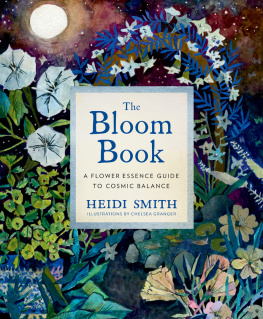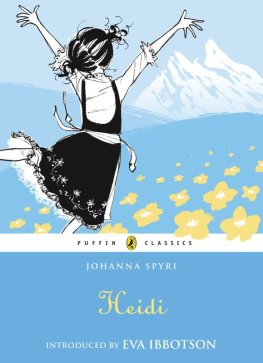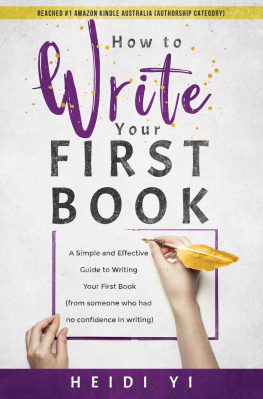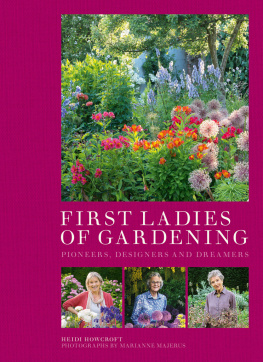Heidi Smith - The Bloom Book
Here you can read online Heidi Smith - The Bloom Book full text of the book (entire story) in english for free. Download pdf and epub, get meaning, cover and reviews about this ebook. year: 2020, publisher: Sounds True, genre: Religion. Description of the work, (preface) as well as reviews are available. Best literature library LitArk.com created for fans of good reading and offers a wide selection of genres:
Romance novel
Science fiction
Adventure
Detective
Science
History
Home and family
Prose
Art
Politics
Computer
Non-fiction
Religion
Business
Children
Humor
Choose a favorite category and find really read worthwhile books. Enjoy immersion in the world of imagination, feel the emotions of the characters or learn something new for yourself, make an fascinating discovery.
- Book:The Bloom Book
- Author:
- Publisher:Sounds True
- Genre:
- Year:2020
- Rating:3 / 5
- Favourites:Add to favourites
- Your mark:
- 60
- 1
- 2
- 3
- 4
- 5
The Bloom Book: summary, description and annotation
We offer to read an annotation, description, summary or preface (depends on what the author of the book "The Bloom Book" wrote himself). If you haven't found the necessary information about the book — write in the comments, we will try to find it.
Heidi Smith: author's other books
Who wrote The Bloom Book? Find out the surname, the name of the author of the book and a list of all author's works by series.
The Bloom Book — read online for free the complete book (whole text) full work
Below is the text of the book, divided by pages. System saving the place of the last page read, allows you to conveniently read the book "The Bloom Book" online for free, without having to search again every time where you left off. Put a bookmark, and you can go to the page where you finished reading at any time.
Font size:
Interval:
Bookmark:
Contents


This book is dedicated to my brother, Stuart, who set me on my path.
Contents

Foreword
AFTER FORTY YEARS OF meditation and spiritual practice, working with others in ceremonies, mystical journeys, and private sessions, I met Heidi Smith. The introduction came from David Groode, a mutual friend and intuitive, who had suggested that Heidi and I work together. We had an initial meeting at my healing center in San Francisco just before she moved to New York City. Then, for seven years, we met every week for one hour on the telephone. I had never had a student more focused, dedicated, and deeply interested in spiritual evolution than she was. Her commitment to awakening the divine feminine within her grew out of her discovery of her own self-worth and value. As she healed herself, her desire to share her own understanding with others became imperative.
In this text, Heidi covers a broad history, offers tools for personal development, and imparts her passion for the unseen realms of the plant kingdom. She incorporates her understanding of the ancient mystical teachings with the shamanic wisdom of the indigenous peoples. Her fresh perspective to awakening the divine feminine and plant consciousness is what makes this an important book.
Heidi offers us an opportunity to examine ourselves. She gives us a historical context for the exile of the feminine in our culture as well as an intuitive understanding of the importance of integrating our temporal selves and our transcendent ones, our feminine aspects and our masculine ones, our mystical nature and our linear minds. We have learned since birth about splitting ourselves, often judging and blaming what we cant understand or appreciate. We have a difficult time admitting our mistakes or failings, often blaming them on others for fear of shame or humiliation. The patriarchy has made vulnerability a sign of weakness rather than wisdom, so people work hard at hiding their true selves rather than being honest about their imperfections.
Our society values money over authenticity, fame over service, adoration over self-love. With The Bloom Book, Heidi has given us a way to intersectionally find and honor all the feminine aspects that we have learned to dissociate, denigrate, and diminish. Out of these chapters we rise up and meet ourselves fully, consciously, and with a toolbox that allows us to be fully integrated humans capable of traversing all realms of consciousness. This book is a personal guide full of understandings that brought Heidi to her own calling: helping people awaken to their own path by working with the unseen teachers of the plant kingdom. Her offerings here empower us to follow our own inner call, our own hearts desiresand in so doing we can find a way to heal not only ourselves but the Earth as well. Nothing is more compelling than learning from the devas and spirits of the plant kingdom, who shine a light on our understanding. The answers we seek lie in all of nature and the Earth we inhabit. The indigenous people of this Earth have always known this; they have honored the animal and plant kingdom as holy spirits. Our insistence on striving to conquer and own our dense material world has destroyed the very place we need for our survival.
The message in The Bloom Book empowers us. We recognize that everything is not as it seems. Heidis own personal guides from the hidden realms taught her about vibrational medicine, healing, and the power of plants. After many years of hard work, she began to trust the voice within and followed the guidance that emanated from there. She also sought out mentors and teachings to enhance the information that came from her own direct experience. Heidi has the capacity to challenge and question her assumptions. She seeks not just to reinforce her own answers but also to challenge them. What she presents here is written with authority and humility.
It is a privilege for me to introduce this book to you. I am so proud of this woman, who, with immense courage, has stepped through many challenges to write with great clarity and passion. I am inspired by her and have great faith that because of her, and others like her, the ancient wisdom will come to lightnot in the cloistered world, but for all of us to understand and incorporate into our daily lives.
Jane Bell
Presence of Heart

CHAPTER ONE
Introduction and My Journey
If you have come here to help me, you are wasting your time. But if you have come because your liberation is bound up with mine, then let us work together.
Lilla Watson
LIKE MANY SEEKERS, I was motivated by pain and existential confusion to find deeper answers for my suffering. When my younger brother committed suicide in 2007, David Groode, a trusted friend and intuitive, introduced me to mimulus, a Bach flower remedy that is meant to help alleviate fear. I didnt know what it was or how it worked, but once I started taking those drops three times per day, I knew they were helping me move forward despite my intensifying anxiety. Since then, I keep several flower remedies in my medicine kit. David also introduced me to Presence of Heart founder and spiritual teacher Jane Bell. Jane would become my mentor and guide for the next seven years.
When I met Jane in 2007, I felt I had found the candle that would illuminate my path forward. With her guidance, we traversed the terrain of my wounding and underlying belief systems. We plumbed the depths of my psyche and found the shadows of the universal consciousnesspatterns and programs ingrained in all beings that could be healed and cleared with intention, commitment to the process, and love. My transformational growth was exponential when I traveled with Jane to Egypta pilgrimage to the ancient holy sites that still resonate with the divine wisdom frequency of the mystery schools. Those sacred temples and the people I met there changed my heart consciousness forever.
In graduate school, studying psychology in the Western mode, I struggled to resolve what I knew about the nature of reality from my mystical studies and what was presented by the medical/academic model. I felt there was so much more to life and healing than merely talking about our physical issues. It also became evident early on that, while I was studying social justice and healing, a lot of the academic structures perpetuatedrather than challengedgender and racial bias.
The bridge I had been waiting forto connect what I knew on a soul level, and what I was called here to do, with academic theories I learned from Carl Jung to Carl Rogerscame in the form of a book given to me by my future husband. It was Gurudass Flower Essences and Vibrational Healing. Gurudas authored several of the earliest books on vibrational medicine with the help of channeler Kevin Ryerson. For me, at that time in my life, the book, although extremely out there, spoke to the vibrational nature of all life.
Vibrational medicine uses specialized forms of energy to positively affect those energetic systems that may be out of balance due to disease states. Flower essences work with higher levels of consciousness, the subtle bodies, the chakras, as well as the physical and biomolecular form. When I refer to flower essences as subtle, I mean that the way they work is energetic and may or may not produce physical effects. The process of working with flower essences can be as gentle as drinking chamomile tea or it can gong you as hard as a psychedelic experience. Flower essences connected me: with healing, with others, with the evolution of the planet, and what I now know as the collective consciousness. They also reinforced my vision of ascensionwe come here to be in our hearts and evolve. Later, I realized that, while returning to school proved to be an enriching and invaluable experience, in truth I had gone there asking the patriarchy for permission that it would not and could not grant: to allow me to be an integrative therapist who uses flower essences. The answers werent there, and the doors were closed. So I sat by myself and waited.
Next pageFont size:
Interval:
Bookmark:
Similar books «The Bloom Book»
Look at similar books to The Bloom Book. We have selected literature similar in name and meaning in the hope of providing readers with more options to find new, interesting, not yet read works.
Discussion, reviews of the book The Bloom Book and just readers' own opinions. Leave your comments, write what you think about the work, its meaning or the main characters. Specify what exactly you liked and what you didn't like, and why you think so.










